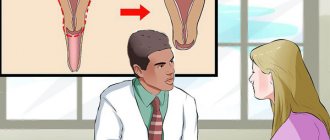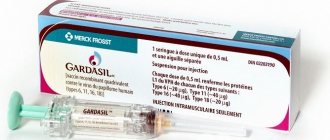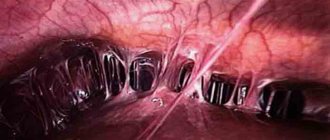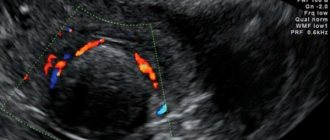Hysterectomy is a complex surgical procedure that involves the complete removal of the uterus: its body and cervix. The reason for such an operation may be severe uterine bleeding, adnexitis, tumor diseases, etc. After performing this surgical treatment, the woman will have a certain recovery period, during which she may notice certain changes in her body and the occurrence of discharge is no exception.
The most important thing in this situation is to learn to understand which discharge after removal of the uterus corresponds to the normal healing process and which does not. If the nature of the mucus has changed dramatically, then you should worry and seek medical help. Discharge mixed with blood clots, pus, a yellow-green color, or a foamy, curd-like, watery consistency may indicate a disruption in the normal healing process.
If itching or burning appears in the vaginal area, you should not ignore these symptoms, since after surgery, only the discharge of leucorrhoea can be an adequate and natural symptom.
Bleeding in hospital
During the initial postoperative stage of rehabilitation, bleeding is a natural indicator of healing. The pelvic organs are supplied with a huge number of blood vessels. During an operation to remove the uterus, even the most gentle one, trauma to the veins and arteries inevitably occurs, disruption of their integrity, and dissection. This causes bleeding. Large vessels are closed during the intervention so that the patient does not lose a large amount of blood. And small vessels and capillaries stop bleeding as the sutures heal.
In addition, before the operation of organ removal and for some time after surgery, the patient is administered blood thinning drugs to prevent the formation of blood clots. This prevents the rapid healing of wounds, so in the early postoperative period, bleeding of low intensity does not cause concern among doctors. As anticoagulant drugs are gradually withdrawn, healing of wound surfaces accelerates.
https://youtu.be/GriA2JZKqKU
Wearing a bandage after a hysterectomy
All women who have had a hysterectomy are advised to wear a post-operative brace. Its dimensions are adjusted depending on the patient’s physique. The bandage helps to fix the abdominal muscles. This helps speed up the healing of sutures and prevent complications. Wearing a bandage is indicated in the late postoperative period. A special corset can be purchased at a pharmacy. It is especially necessary if a woman has a history of several births.
Also, all patients with weak muscles of the anterior abdominal wall should wear a postoperative bandage. The dimensions of the corset must correspond to the location of the seams. If the length of the bandage can be adjusted, then the width should be selected individually. It is recommended that the corset covers the scar by 1 cm from the bottom and top.
Measures to control bleeding
Arterial or venous bleeding will not stop on its own. Large blood loss can lead to serious complications, including death. Therefore, urgent ligation of the vessel is required. For this purpose, repeated penetration into the intraperitoneal space is carried out laparoscopically or using an incision in the abdomen. During surgery, the bleeding vessel is carefully sutured.
To be fair, it must be said that such dangerous complications after removal of the uterus are very rare: during the operation, careful treatment of the cut vessels is a special concern of surgeons.
Rehabilitation in a hospital, depending on the volume of intervention and the progress of recovery, lasts from 1 to 4 weeks.
Important! When the uterus is removed due to cancer, the scope of the operation is much larger; additional procedures are performed at the postoperative stage, so recovery lasts longer, and bleeding is of a different nature.
Preparing for surgery
A blood test, its biochemical composition and the state of the coagulation system are examined. An X-ray of the lungs is performed. To evaluate metastases in the lymph nodes, CT, MRI or positron emission tomography is performed. When diagnosing inflammatory diseases, the infection is treated until complete recovery.
Before removing part of the cervix, doctors determine whether the patient is suitable for such an operation. She is then explained in detail that during the operation, damage to blood vessels, ureters and other organs may occur, which may require immediate laparotomy.
Alternative treatment methods are discussed: cervical conization, hysterectomy, chemoradiotherapy.
In some patients, right during the intervention, it is necessary to expand its volume and remove the uterus if metastases to the lymph nodes are detected.
The woman is hospitalized on the day of the operation or the day before it. She should not eat or drink 6 hours before the intervention. Some medications may be administered as prescribed by the doctor.
The patient signs a consent form for the operation, which contains information about possible complications.
Outpatient recovery mode
If the development of events is favorable, the patient who has undergone hysterectomy is discharged for further observation by the local antenatal clinic doctor.
At this time, slight bloody discharge from the genitals still persists. But as you recover, their intensity decreases. Over time, the type and amount of discharge changes as follows:
| Time | Volume | Color | Peculiarities |
| immediately after surgery | abundant | Red | sometimes with small clots |
| for 2 – 4 days | less abundant | red-burgundy | without clots (due to the patient’s physical activity) |
| 5 – 10 days | sparse | burgundy brown | |
| 10 – 15 days | meager | brown | |
| 16 – 21 days | light brown | meager | |
| from 22 days | meager | transparent with an admixture of ichor | transparent |
About a month after removal of the uterus, all discharge becomes clear.
High uterine amputation
If fibroid nodes are located in the fundus or upper part of the uterus, the optimal choice of surgical intervention is high amputation of the uterus. During the first stage of its implementation, the appendages are cut off from the uterus and, together with the peritoneum, are lowered down in order to free the branches of the uterine artery to the border of the planned cutoff. At the same time, the uterine vessels are intersected and ligated. Then the fundus and part of the body of the uterus are cut off along a line parallel to the course of the vessels in this area. After removing part of the uterus, the remaining muscular and serous layers are sutured in layers, forming a uterus, to the lateral surfaces of which the previously cut off appendages are sewn, using round uterine ligaments for peritonization.
Symptoms characteristic of bleeding
If during inpatient rehabilitation the patient’s well-being is carefully monitored by medical staff daily, then during outpatient treatment the lion’s share of responsibility falls on the patient herself.
The correct course of recovery after removal of the uterus is not accompanied by increased pain and discharge. The following symptoms can cause anxiety, and therefore an unscheduled visit to the gynecologist:
- sudden or gradual increase in bloody discharge;
- the occurrence of acute, nagging or aching pain in the area of surgery or the external suture;
- the appearance of pus in bloody discharge;
- change and intensification of the smell, which becomes unpleasant (putrid, rotten, fishy, etc.);
- increased body temperature;
- general deterioration of health.
Possible complications after hysterectomy surgery
Any surgical intervention is fraught with dangerous consequences for the body. Immediately after removal of the uterus, some patients observe:
- Redness or swelling of the skin around the stitches or in the abdominal area.
- Purulent discharge or bleeding from the wound.
- Pain and other problems with urination.
- Inflammatory process in the abdominal cavity - this phenomenon leads to damage to internal organs, sometimes it develops into sepsis.
- Pulmonary embolism is the most severe complication leading to blockage of blood vessels and can even be fatal.
If in the first days heavy bleeding is considered normal, then after two weeks it is a pathology. An unpleasant, foul smell of secretion is also a reason to consult a doctor. A similar sign may indicate inflammation in the vagina. If this phenomenon is started, cases of peritonitis and sepsis are not uncommon. Severe bleeding from the vagina requires urgent medical measures.
An increase in body temperature and a general deterioration in well-being are signs of infection of a postoperative suture. To stop this reaction, it is necessary to take a course of antibiotics and periodically treat the wound with a special composition.
The development of peritonitis, as one of the most serious complications of hysterectomy, also contributes to general malaise and an increase in temperature up to 40 ° C, with signs of irritation of the abdominal cavity and pain.
In each specific case, treatment is determined taking into account the progress of the primary operation, tissue restoration and healing, as well as anamnesis and individual characteristics of the body (presence of concomitant diseases, allergies, etc.).
Prevention of complications
After any abdominal surgery, such as hysterectomy, a very important point in the rehabilitation program is to prevent bleeding. To do this, gynecological patients are recommended to follow the easy rules of self-preservation:
- do not spend a long time in bed - early physical activity in feasible quantities stimulates proper metabolism and body reactions aimed at healing wounds;
- do not overload the body - physical activity is allowed in doses, not to the point of exhaustion; exercise should be stopped at the first signs of fatigue;
- do not lift heavy objects - the luggage weight is allowed from 1 to 3 kg, without exceptions;
- abolish unhealthy habits - smoking causes vasospasm, alcohol causes dilation followed by spasm, sweets contribute to the deposition of cholesterol on the walls of blood vessels, a sedentary lifestyle leads to blood stagnation and the formation of blood clots;
- do not visit the bathhouse, do not take a bath - during the outpatient period, only taking a shower is possible;
- do not sunbathe - overheating can lead to disaster;
- switch to a healthy diet - do not load the gastrointestinal tract with smoked meats, pickles, sweets and preserves - this significantly worsens the composition of the blood and the strength of blood vessels, and increases the likelihood of bleeding.
Advantages and disadvantages of subtotal hysterectomy
The main arguments in favor of preserving the cervix during hysterectomy (removal of the uterus) are the following factors:
- after the operation, the ligamentous apparatus of the uterus is preserved;
- the likelihood of urodynamic disorders of the urinary tract is reduced;
- Sexual desire and sensitivity are not impaired.
The most serious disadvantage of this method is the risk of malignancy (malignancy of cells) of the cervix. In view of this, most specialists insist on removing this organ, preferring to perform a total rather than a subtotal hysterectomy. Feedback from experienced doctors suggests that, provided Pappanicolaou smears are negative for malignant cells, only 0.3% of women are likely to develop cervical cancer.
Long-term recovery period
At the end of inpatient and outpatient rehabilitation after removal of the uterus, the woman is discharged from sick leave and becomes able to work again. There is no bloody discharge or pain during this period; this is the main indicator of recovery.
The condition is normalized and opportunities expand. It is useful to include swimming and cycling in physical activity. Hygiene procedures are allowed to be supplemented by taking a bath. As before, you should not abuse direct and prolonged exposure to sunlight, but diffused light is beneficial - calcium absorption occurs much more intensely, and after a forced change in hormonal balance, it is more important than ever.
Recovery and aftermath
For 7 days after the operation, the patient should be under the supervision of medical staff. She should be provided with the following medical services:
- prescription of painkillers (if required);
- prescribing antibiotics to reduce the risk of inflammation;
- installation of a urinary catheter.
After discharge, the patient must follow medical recommendations:
- It is necessary to minimize intense physical activity;
- You need to stop using tampons for a while;
- It is not recommended to take too hot baths or showers for 6 weeks.
Sex after cervical removal
Many women who have undergone cervical amputation fear an inadequate sex life. Gynecologists are rushing to dispel these fears. Due to the sensitivity of the vaginal walls, patients retain the ability to experience orgasm. The only inconvenience is long-term abstinence (for 6 weeks) from sexual intercourse with your partner.
Complications
In some cases, amputation of the cervix is accompanied by complications, among which purulent infections, sepsis, and bleeding are most often observed. When an operation is performed by an unqualified doctor, necrosis of the vaginal dome may develop.
In order to exclude the presence of unpleasant complications, the gynecologist prescribes a routine examination. 2 weeks after amputation, you need to make sure that the rehabilitation period is proceeding smoothly.
Can be produced by various methods. This is due to the degree of its damage and hypertrophy.
There are the following methods of performing the operation:
High cervical amputation;
Cone-shaped removal;
Diathermoconization.
This surgical intervention is prescribed for severe deformation as a result of multiple ruptures, for chronic endocervicitis with connective tissue degeneration, hypertrophy or the presence of recurrent polyps. In addition, amputation of the cervix is indicated for leukoplakia, follicular hypertrophy, long-term non-healing or recurrent erosion, as well as erythroplakia.
The high removal method is used for adenoma, deep ruptures in combination with ectropion (eversion of the mucosa). In addition, this technique is used in cases of pronounced elongation of the cervix extending beyond the genital slit.
Cone-shaped amputation is advisable for recurrent erosions accompanied by recurrent polyps.
Wedge-shaped amputation of the cervix is prescribed for moderate follicular hypertrophy, as well as for other pathologies that do not require high amputation.
If cancer is diagnosed, the diathermoconization method using an electric knife or the cone-shaped knife removal method can be used. In this case, the first method is more appropriate.
Supravaginal amputation of the uterus is the surgical removal of the organ body in the area of the internal os in the area of the supravaginal portion of the cervix. Thus, after the intervention, only the cervix remains.
In some cases, the body of the uterus is removed slightly higher than the internal os. This allows you to save a small area of the endometrium (mucous membrane). In the presence of functioning ovaries in a reduced (reduced) form, it (the endometrium) goes through the same stages of changes as during the menstrual cycle. As a rule, there are no periods after supravaginal removal.
During such an intervention, the vagina does not have to be opened. In the area of the internal pharynx, the contents are usually sterile. In this case, the supravaginal removal of the uterus, carried out by the abdominal-wall method, is an intervention that takes place under the conditions of an aseptic surgical field. The exception is when surgery is performed for inflammation in the appendages of an organ, perforation or spontaneous rupture during pregnancy.
Uterine amputation. Consequences
Intraoperative complications include damage to the ureters and bladder.
More dangerous consequences are the formation of hematomas and bleeding. Hemorrhages in the postoperative period are quite difficult to diagnose and eliminate. This is due to the fact that they occur in a closed space (parametrium), and then into the abdominal cavity (or directly into it). In this regard, during the peritonization phase of the stump of all vessels and ligaments, a repeated examination and, if necessary, additional dressing are performed (especially in the presence of massive ligatures and dilated varicose vessels). If necessary, to control hemostasis, mandatory drainage of the peritoneum or an increase in the volume of surgical intervention is carried out before extirpation.
Postoperative consequences include the formation of hematomas and bleeding. In such cases, relaparotomy is indicated after the intervention. In case of late diagnosis, suppuration of hematomas, relaparotomy, drainage and sanitation of the pelvis, and extirpation of the stump are prescribed.
Excision is the process of removing damaged tissue from the cervix. Modern medicine offers several ways to perform this operation, but laser and radio wave surgery are considered the safest. There is also a loop method, or electrosurgical intervention, but it is gradually being abandoned, since it is quite difficult to control the depth of tissue coagulation, which complicates the excision procedure.
Special conditions
After removal of the uterus, a woman's menstrual cycle stops. There is no regular bleeding.
Important information! If the ovaries and uterine stump have not been removed, monthly spotting is possible: there is probably a small amount of endometrium on the preserved part of the uterus. It is rejected in the absence of fertilization (as in a healthy woman).
This should not cause concern if the discharge is not abundant and does not intensify. This phenomenon will stop with menopause.
Thus, a properly proceeding recovery period after surgery is a gradual but steady improvement in well-being, the struggle to reduce and stop bleeding, the fight against complications, and the expansion of the body’s functional capabilities. Organizing your lifestyle at this time is an important factor on the path to recovery.
In what cases is the cervix removed?
Early stages of cancer, in which only the neck is affected - and shallowly - and the rest of the surrounding tissue is healthy. In this case, if a woman is young and wants to become a mother in the future, the cervix itself, the upper part of the vagina, part of the tissue around the affected area, and sometimes also the pelvic lymph nodes are removed (the so-called radical trachelectomy). The risk of relapse after such an operation (if it was preceded by a thorough examination and an accurate diagnosis was made) is negligible. Some forms of cervical hypertrophy. Hypertrophy (enlargement, growth) of the cervix can be provoked by pathological processes: prolapse of the uterus, disruption of the cervical glands, chronic inflammation of the mucous membrane of the cervical canal or the uterus itself, fibroids in the cervical area. Chronic endocervicitis with recurrent cervical polyps. Ectropion is a consequence of cervical ruptures during difficult childbirth or late abortions. The mucous membrane of the cervical canal seems to turn inside out and protrude into the vagina. It becomes inflamed, eroded, and may undergo malignant degeneration. Cervical deformities. The causes may be congenital anomalies, scars after operations, or cervical ruptures. Severe forms of leuko- or erythroplakia and cervical erosion that cannot be treated conservatively.
Recovery after hysterectomy: first 24 hours
The first postoperative day is especially difficult. At this time, the woman feels quite severe pain inside the abdomen, as well as in the area of the sutures, which is not surprising, since there are wounds both inside and outside. To relieve pain, the doctor prescribes narcotic and non-narcotic painkillers.
The patient's lower limbs are bandaged with elastic bandages or in compression stockings (prevention of thrombophlebitis).
Doctors are of the opinion that the patient needs to be active after surgery. It is better for her to get out of bed earlier (in a few hours - a maximum of a day). Such physical activity perfectly “accelerates the blood” and promotes normal intestinal function.
During the first day after surgery, the doctor prescribes a gentle diet, which includes broths, pureed food and liquids (still mineral water, weak tea, fruit drinks). Such a treatment table gently stimulates intestinal motility and promotes early (1-2 days) spontaneous bowel movement. Independent stool indicates the normalization of intestinal function, which indicates the possibility of switching to familiar foods.
The abdomen after surgery remains sensitive and painful, usually from 3 to 10 days - everything will depend on the woman’s sensitivity threshold to pain. It should be noted that the more actively the patient behaves after surgery, the sooner her normal state is restored and the lower the likelihood of possible complications.
What is the operation?
Trachelectomy can be performed in different ways. The most common surgical techniques are Schroeder (wedge amputation) and Sturmdorff (cone amputation), as well as high cervical amputation. The sutures used most often are catgut and absorbable, although some surgeons prefer silk or nylon.
- Wedge amputation
The essence of the operation consists in excision of tissue (in the form of a wedge) inside each of the lips of the neck (there are two of them: anterior and posterior). In this way it is convenient to remove, for example, overgrown and cystic glands lying in the submucosal layer. The remaining flaps of the mucous membrane are sewn together, restoring both lips of the cervix (of course, they become shorter).
Cone amputation
In this case, most of the mucous membrane of the cervical canal is removed: the removed part has the form of a funnel directed deep into the cervix. The wound surface is covered with a flap of mucous membrane, which makes up the “skirt” of the cone.
High cervical amputation
The peculiarity of the operation is that the entire cervix is cut off, and cuts are made on the vaginal mucosa around it. The operation is quite complex and can only be performed by experienced surgeons. It is necessary to prevent possible damage to the bladder and ligate the branch of the uterine artery that approaches the wall of the cervix. The neck is incised and removed. The vagina is tamponed, that is, filled with a gauze bandage soaked in an antiseptic or sterile oil.
When should you visit a doctor for an examination?
At discharge, a cervical examination with insertion of a speculum into the vagina is not performed.
You should visit a doctor two weeks after surgery. If necessary (presence of leucorrhoea), he may prescribe careful douching with an antiseptic solution, but will not examine the vagina yet.
The first examination through the vagina is recommended (as well as return to sexual activity) one and a half months after menstruation has passed. In addition to the examination, a smear is taken for cytological analysis, a colposcopy is prescribed, and an MRI is prescribed if indicated.
Normal discharge
Removal of the uterus is scientifically called a hysterectomy.
In most cases, it is performed for cancer of the female reproductive system. Sometimes surgery is performed as a preventative measure to prevent cancer. Despite the prevalence of this method abroad, many women are afraid of the consequences of a hysterectomy. This fear is justified. After all, such an operation can lead to serious consequences. Some patients experience discharge after hysterectomy. Normally, they are observed within several days.
Naturally, the discharge is not associated with endometrial rejection and the menstrual cycle. After all, after extirpation of the organ, this is impossible. In most cases, they are associated with failure of the sutures and the oncological process that remains in the abdominal cavity. In some cases, bleeding may be caused by damage to nearby organs during surgery.
During the normal course of physiological processes, each woman secretes approximately 1-2 ml of clear or whitish discharge from the vagina throughout the day. The composition of this liquid is as follows:
- mucous discharge from the cervical canal and its cavity;
- secretion of goblet cells of the vagina and vaginal part of the uterus;
- dead epithelium and single leukocytes;
- various bacteria and their metabolic products.
Based on these data, it can be understood that the secretion of mucus is physiological for a woman. However, it should not contain any admixture of blood or purulent discharge. After removal of the uterus, the discharge does not stain underwear, does not have a specific odor and does not irritate the mucous membrane of the internal and external genital organs.
Life after resection
Despite the fact that the patient's life undergoes significant changes, it is possible to adapt to them. You can find a large number of horror stories about this on the Internet. The first of them concerns sex life. It is important to understand that the areas that are responsible for pleasure from sexual intercourse are located at the entrance to the vagina, and not in the uterus, so removal of the organ does not affect orgasm.
Patients report pain only when there is a scar in the vagina, which occurred during radical hysterectomy. After surgery, there is a risk of formation of adhesions, which are indicated by the appearance of:
- flatulence;
- dyspeptic phenomena, which occur very often;
In order to minimize the chance of their occurrence, it is important to return to movement as soon as possible after surgery. The doctor may also recommend antibiotics and anticoagulants.
The period after surgery is never easy, but if you follow all the recommendations, you can go through this period as quickly and painlessly as possible and return to your normal lifestyle.
Hysterectomy is a procedure that is performed on the strict recommendation of a doctor. After removal of the uterus, discharge bothers the woman for a long time. After all, its consequences are often even more serious than the operation itself. So, they no longer resemble menstruation, during which the stomach often feels tight or the lower back hurts, but in any case, it is necessary to pay attention to how this discharge passes.
There are a number of other consequences that you will have to learn to live with after the procedure.
The first day after surgery is the hardest
Most often, women have their uterus removed if they are diagnosed with cancer of the uterus or cervix. Also among the reasons for surgical intervention are heavy bleeding, benign tumors that appeared after menopause, severe prolapse of the uterus, and gynecological pathologies.
Of course, surgery is considered as the last treatment option that cannot be avoided. In such cases, the patient cannot choose, but must adhere to the doctor's recommendations.
The operation can be performed using various methods depending on the severity of the disease, the location of the tumor and other factors:
- abdominal method - in this case the uterus is removed through an incision in the abdomen;
- vaginal – all manipulations are carried out through the vagina and the stitches are invisible after the operation;
- laparoscopic - small incisions are made in the lower abdomen through which they operate.
With any of these methods, the woman is in the hospital for five to ten days. The first day after the procedure is considered the most difficult, because the woman has severe stomach pain, it is difficult for her to move, she needs to stick to a diet, and problems with stool may appear.
After removal of the cervix, the patient may have complications that must be paid attention to. These include:
- Inflammatory processes in the area of the surgical suture.
- Painful urination.
- Bleeding.
- Peritonitis.
- Hematomas in the abdominal area.
- the discharge has a sharp unpleasant odor, which is either rotten;
- blood clots appeared;
- the discharge became bloody;
- The discharge has intensified and requires frequent changes of the pad. There can be 2-3 pads per hour.
All these complications can be diagnosed by a doctor during the patient’s hospital stay. During the time that a woman is in the hospital, many of these complications go away with proper care.
Discharge can last a whole month
Vaginal discharge may continue after discharge.
So, if a woman notices that the discharge has become bright red or with blood clots, she should urgently consult a doctor, as this may indicate internal bleeding.
If the discharge is scanty and seems to be “smeared”, this is the norm: this is how the suture heals after surgery. You should consult a doctor if:
All these symptoms may indicate that an inflammatory process has begun, which can lead to sepsis if you do not seek help in time. Remember, heavy bleeding from the genital tract after such an operation is a dangerous symptom!
However, some doctors note that discharge after removal of the uterus is a normal process that can last a whole month.
The main thing is that their frequency should not increase. Discharge may occur due to the fact that the activity of the ovaries is not affected and the influence of sex hormones on the cervix occurs.
Life after surgery!
Often, in order to save the patient from postoperative complications, doctors prescribe certain recommendations, following which you can quickly return to your normal pace of life.
There are a number of factors that frighten women who have undergone this operation. Many people think that they will become more masculine, their hair growth will increase, their voice will change, and the sensations during sex will be different. All these are far-fetched thoughts. So, if a woman only had her uterus removed and her ovaries were preserved, she will still experience sexual desire and will enjoy sex even more. After all, she will get rid of the pain in the lower abdomen, and the risk of getting pregnant will now not play a role for her. Often, women after a hysterectomy become even more relaxed in bed.
Separately, I would like to emphasize that after such an operation, life expectancy increases and the woman will not be susceptible to uterine cancer, and today, during a sharp increase in oncology among the population, this says a lot.
Of course, the postoperative period is not honey, it will be difficult to learn to live without a uterus, and this takes time. The main thing is to watch yourself during this time - do not miss important symptoms that may indicate a deterioration in your condition. Discharge after hysterectomy should not be abundant or too long! Remember that it is because of bleeding that a woman sometimes has to go back to the operating table. Be attentive to yourself!
The operation to remove the uterus (hysterectomy or hysterectomy) is one of the most common in the practice of operative gynecology.
It is carried out when all other possible treatment methods have demonstrated their ineffectiveness, and when it comes to saving the patient’s life. In some cases, during this surgical procedure, in addition to the uterus, the ovaries and fallopian tubes are also removed. Let's consider the consequences of the operation and recovery after hysterectomy.
Hysterectomy: postoperative period
All women experience heavy discharge after hysterectomy. This phenomenon is considered normal during the first 24 hours. In the early postoperative period, bleeding is caused by vascular damage. It should be borne in mind that a hysterectomy is a serious surgical procedure that involves the entire pelvic cavity.
Therefore, after removal of the uterus, spotting and spotting are observed for a long time. They can last up to 6 weeks. If, instead of spotting, there is heavy blood loss, you should immediately inform your doctor. Otherwise, the complication can lead to shock and death.










